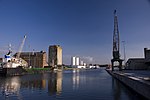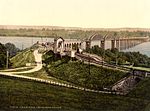Purton Hulks

The Purton Hulks or Purton Ships' Graveyard is a number of abandoned boats and ships, deliberately beached beside the River Severn near Purton in Gloucestershire, England, to reinforce the river banks. Most were beached in the 1950s and are now in a state of considerable decay. The site forms the largest ship graveyard in mainland Britain.A riverbank collapse in 1909 led to concerns that the barrier between the river and the Gloucester and Sharpness Canal would be breached. Old vessels were run aground and soon filled with water and silt to create a tidal erosion barrier. The vessels included steel barges, Severn trows and concrete ships. The boats came from throughout the British Isles and were built in the second half of the 19th century and the first half of the 20th. Since 2000, archaeological investigations have been undertaken to find out more about the vessels and their states of decay. Explanatory labels have been provided. One barge has been scheduled as an ancient monument and several are included in the National Register of Historic Vessels.
Excerpt from the Wikipedia article Purton Hulks (License: CC BY-SA 3.0, Authors, Images).Purton Hulks
OHN2,
Geographical coordinates (GPS) Address External links Nearby Places Show on map
Geographical coordinates (GPS)
| Latitude | Longitude |
|---|---|
| N 51.735833333333 ° | E -2.4575 ° |
Address
Purton Hulks
OHN2
GL13 9HX
England, United Kingdom
Open on Google Maps







